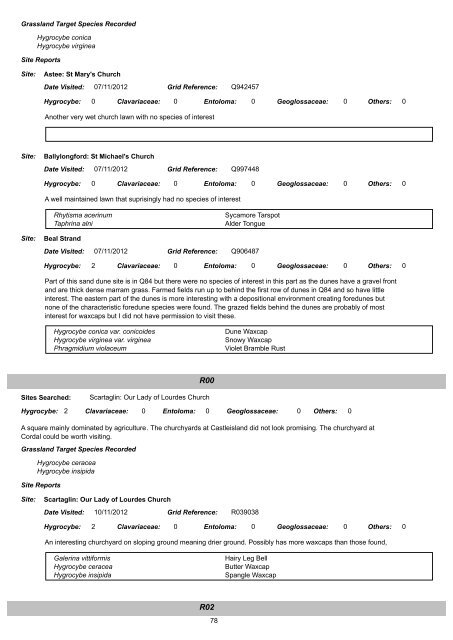North Kerry Waxcap Survey 2012 - the Northern Ireland Fungus Group
North Kerry Waxcap Survey 2012 - the Northern Ireland Fungus Group
North Kerry Waxcap Survey 2012 - the Northern Ireland Fungus Group
You also want an ePaper? Increase the reach of your titles
YUMPU automatically turns print PDFs into web optimized ePapers that Google loves.
Grassland Target Species Recorded<br />
Hygrocybe conica<br />
Hygrocybe virginea<br />
Site Reports<br />
Site: Astee: St Mary's Church<br />
Date Visited: 07/11/<strong>2012</strong><br />
Grid Reference: Q942457<br />
Hygrocybe:<br />
0<br />
Clavariaceae:<br />
Ano<strong>the</strong>r very wet church lawn with no species of interest<br />
Site: Ballylongford: St Michael's Church<br />
0<br />
Entoloma:<br />
Date Visited: 07/11/<strong>2012</strong><br />
Grid Reference: Q997448<br />
Hygrocybe:<br />
0<br />
Clavariaceae:<br />
Entoloma:<br />
A well maintained lawn that suprisingly had no species of interest<br />
Site: Beal Strand<br />
Rhytisma acerinum Sycamore Tarspot<br />
Taphrina alni Alder Tongue<br />
Date Visited: 07/11/<strong>2012</strong><br />
Grid Reference: Q906487<br />
Hygrocybe:<br />
2<br />
Clavariaceae:<br />
0<br />
0<br />
Entoloma:<br />
0<br />
0<br />
0<br />
Geoglossaceae:<br />
Geoglossaceae:<br />
Geoglossaceae:<br />
0<br />
0<br />
0<br />
O<strong>the</strong>rs: 0<br />
O<strong>the</strong>rs: 0<br />
O<strong>the</strong>rs: 0<br />
Part of this sand dune site is in Q84 but <strong>the</strong>re were no species of interest in this part as <strong>the</strong> dunes have a gravel front<br />
and are thick dense marram grass. Farmed fields run up to behind <strong>the</strong> first row of dunes in Q84 and so have little<br />
interest. The eastern part of <strong>the</strong> dunes is more interesting with a depositional environment creating foredunes but<br />
none of <strong>the</strong> characteristic foredune species were found. The grazed fields behind <strong>the</strong> dunes are probably of most<br />
interest for waxcaps but I did not have permission to visit <strong>the</strong>se.<br />
Sites Searched:<br />
Hygrocybe conica var. conicoides Dune <strong>Waxcap</strong><br />
Hygrocybe virginea var. virginea Snowy <strong>Waxcap</strong><br />
Phragmidium violaceum Violet Bramble Rust<br />
R00<br />
Scartaglin: Our Lady of Lourdes Church<br />
Hygrocybe: 2 Clavariaceae: 0 Entoloma: 0 Geoglossaceae: 0 O<strong>the</strong>rs: 0<br />
A square mainly dominated by agriculture. The churchyards at Castleisland did not look promising. The churchyard at<br />
Cordal could be worth visiting.<br />
Grassland Target Species Recorded<br />
Hygrocybe ceracea<br />
Hygrocybe insipida<br />
Site Reports<br />
Site: Scartaglin: Our Lady of Lourdes Church<br />
Date Visited: 10/11/<strong>2012</strong><br />
Grid Reference: R039038<br />
Hygrocybe:<br />
2<br />
Clavariaceae:<br />
0<br />
Entoloma:<br />
0<br />
Geoglossaceae:<br />
0<br />
O<strong>the</strong>rs: 0<br />
An interesting churchyard on sloping ground meaning drier ground. Possibly has more waxcaps than those found,<br />
Galerina vittiformis Hairy Leg Bell<br />
Hygrocybe ceracea Butter <strong>Waxcap</strong><br />
Hygrocybe insipida Spangle <strong>Waxcap</strong><br />
R02<br />
78


